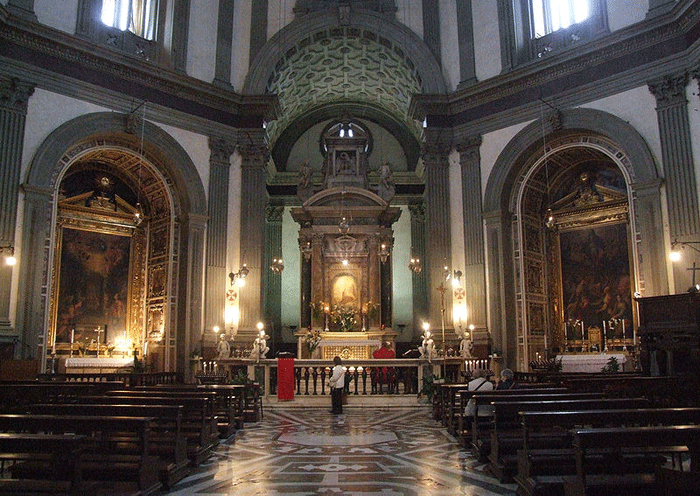At the entrance the visitors arrive into a great vestibule, on the site of the medieval church of Santa Maria, then step through the vast octagonal room, adorned with six chapels richly decorated with paintings, frescos, and golden plastering, completed during the second half of the 17th century. On the right, by the main altar you can see the 16th century Rospigliosi Chapel, with Ludovico Buti's 'pala dell'Annunciazione' and the frescos with the 'Storie della Vergine' by Alessandro Fei, also known as il Barbiere. Then there is the 17th century Chiarenti chapel, with the 'Adorazione dei Pastori' and the frescos by Pietro Sorri. Finally there is the Crucifix chapel with the wooden 'Crucifix' by Pier Maria Rutati from 1633 and, the 18th century frescos by Giovan Domenico Ferretti. On the left of the main altar there is the 16th century Rospigliosi Chapel with the 'Assunzione' by Giovan battista Naldini and the frescos with the 'Storie della Vergine' by Francesco Morandini called the Poppi. Then there is the 17th century Panciatichi chapel with the 'Adorazione dei Magi' by Francesco Vanni and the frescos by Alessio Gimignani. And finally, there is the Alluminati chapel with the 'Riposo dalla fuga in Egitto' by Lazzaro Baldi from the second half of the 17th century. On the walls of the great vestibule there are some frescos from the 18th and 19th century.  The four paintings on the wall in front of the main door were commissioned in 1716 by the prominent Pistoiese Bishop Carlo Agostino Fabroni and were painted by Gian Domenico Piastrini. The works have been inserted into plaster frames with the Fabroni family badge above and they represent the miracles performed by the Madonna of humility, the foundation of the Church, and the transfer of the sacred painting. From the second half of 18th century to the first half of the 19th century the other four paintings were done: 'La maledizione di Caino e San Felice che esorcizza un'ossessa' by Nicola Monti, 'L'apparizione del Bambino Gesù a Sant'Antonio da Padova' by Giuseppe Gricci and 'La Vergine in gloria che appare a San Francesco' by Vincenzo Meucci.
The four paintings on the wall in front of the main door were commissioned in 1716 by the prominent Pistoiese Bishop Carlo Agostino Fabroni and were painted by Gian Domenico Piastrini. The works have been inserted into plaster frames with the Fabroni family badge above and they represent the miracles performed by the Madonna of humility, the foundation of the Church, and the transfer of the sacred painting. From the second half of 18th century to the first half of the 19th century the other four paintings were done: 'La maledizione di Caino e San Felice che esorcizza un'ossessa' by Nicola Monti, 'L'apparizione del Bambino Gesù a Sant'Antonio da Padova' by Giuseppe Gricci and 'La Vergine in gloria che appare a San Francesco' by Vincenzo Meucci.
 The four paintings on the wall in front of the main door were commissioned in 1716 by the prominent Pistoiese Bishop Carlo Agostino Fabroni and were painted by Gian Domenico Piastrini. The works have been inserted into plaster frames with the Fabroni family badge above and they represent the miracles performed by the Madonna of humility, the foundation of the Church, and the transfer of the sacred painting. From the second half of 18th century to the first half of the 19th century the other four paintings were done: 'La maledizione di Caino e San Felice che esorcizza un'ossessa' by Nicola Monti, 'L'apparizione del Bambino Gesù a Sant'Antonio da Padova' by Giuseppe Gricci and 'La Vergine in gloria che appare a San Francesco' by Vincenzo Meucci.
The four paintings on the wall in front of the main door were commissioned in 1716 by the prominent Pistoiese Bishop Carlo Agostino Fabroni and were painted by Gian Domenico Piastrini. The works have been inserted into plaster frames with the Fabroni family badge above and they represent the miracles performed by the Madonna of humility, the foundation of the Church, and the transfer of the sacred painting. From the second half of 18th century to the first half of the 19th century the other four paintings were done: 'La maledizione di Caino e San Felice che esorcizza un'ossessa' by Nicola Monti, 'L'apparizione del Bambino Gesù a Sant'Antonio da Padova' by Giuseppe Gricci and 'La Vergine in gloria che appare a San Francesco' by Vincenzo Meucci.



